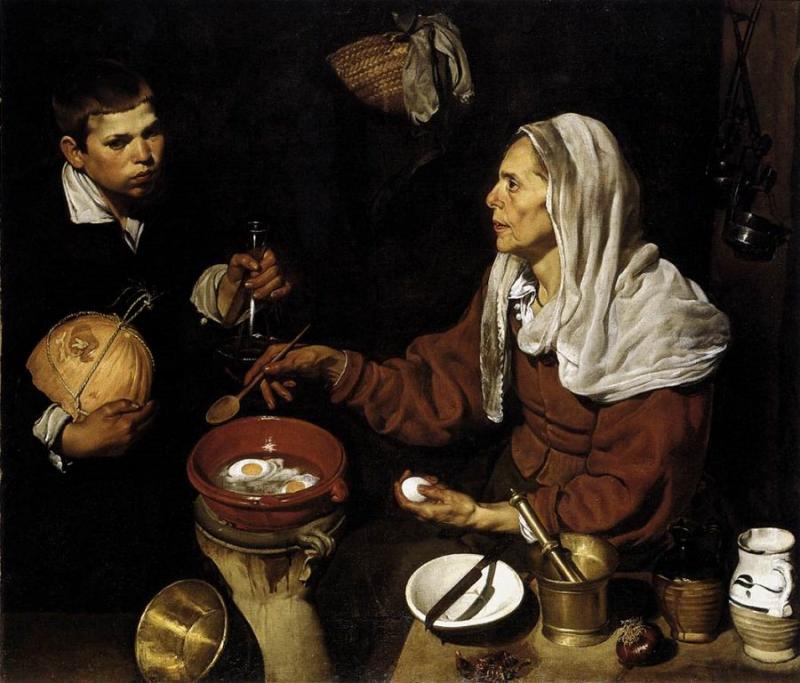Amy Sackville: Painter to the King review - portrait of the artist in shadow and light | reviews, news & interviews
Amy Sackville: Painter to the King review - portrait of the artist in shadow and light
Amy Sackville: Painter to the King review - portrait of the artist in shadow and light
A novel about Velázquez that does justice to his genius – and his mystery

Inevitably, the story begins and (almost) ends with Las Meninas. Inspired by the art and life of Diego Velázquez, Amy Sackville tops and tails her third novel with his endlessly enigmatic group portrait from 1656. It shows the Spanish royal household, their dwarves, a mastiff, a perplexing reflection of the King and Queen in a mirror – and the court painter himself, trapped forever in this nest of “sometimes impossible frames”.
So an author who picks this subject faces brilliant neighbours, their paint still fresh, already hanging on the wall of the same gallery. It is hugely to Sackville’s credit that she manages to craft a novel from this much-visited material that not only triumphs as self-standing fiction, but incorporates into its making the enchantment, and bewilderment, that always awaits viewers of Velázquez. Like Cumming and Jacobs, Sackville puts herself – or rather, an author-figure whom we follow along the artist’s biographical trail – into the picture. From that initial encounter with Las Meninas at the Prado in Madrid, up to a valedictory search for “the true mark of your hand” in Velázquez’s canvases and letters, the novel proceeds not as an objective chronicle of facts and events (many of them still disputed) but a collaborative journey. It recruits the reader as a partner in this quest to discover a real artist and his times through the medium of fiction.
Rather than entire pictures, small, illustrative details of Velázquez’s works stud the text – here a nose topped with spectacles, there eggs hardening in a pan. Sackville sticks admirably close to the documentary record from the moment that, in the early 1620s, the young master-painter from Seville arrives in Madrid. There he begins his almost four decades of loyal service – and draining drudgery – at the court of King Philip IV. Yet Sackville (below) never flinches from the uncertainties and obscurities that surround his (eminent but humdrum) career and (proud but self-effacing) personality. We can glimpse the whole only through fragmentary parts. Over many areas of darkness, only the writer’s imagination can shed light.
The radically free and bold brushwork of Velázquez depicts a “shattered world made whole out of shadow and points of light”. Likewise, the novel flecks its pursuit of the artist, across paintings and documents, with the shimmer and dazzle of its rhapsodic prose. Snatches of interior monologue, immersive torrents of consciousness, flurries of sense-impressions: Sackville’s sumptuous verbal artistry both fills history’s gaps, and offers via its kaleidoscopic language a response to the paintings’ ever-shifting qualities of “plasticity, rigidity, fragility, damage and flaw”. In homage to the “realms made by the paintbrush”, she builds her own kingdom of words.
 Painter to the King, however, does more than transform into language the flux and play of vision caught by Velázquez as he renders “the texture of a moment”. This is also the story of a great artist snared in the spider’s web of power. Halfway between a glorified butler and a senior civil servant, Velázquez must not only paint Philip IV, his family and courtiers in an unceasing round of commissions that he can’t refuse. He helps to manage the royal household, repair its buildings and (in the 1630s) oversee the construction and – super-ornate – decoration of the king’s new Retiro palace on the outskirts of Madrid. Meanwhile, the Spanish empire – though still enriched by the gold and silver plundered from the Americas – stumbles pompously towards decay.
Painter to the King, however, does more than transform into language the flux and play of vision caught by Velázquez as he renders “the texture of a moment”. This is also the story of a great artist snared in the spider’s web of power. Halfway between a glorified butler and a senior civil servant, Velázquez must not only paint Philip IV, his family and courtiers in an unceasing round of commissions that he can’t refuse. He helps to manage the royal household, repair its buildings and (in the 1630s) oversee the construction and – super-ornate – decoration of the king’s new Retiro palace on the outskirts of Madrid. Meanwhile, the Spanish empire – though still enriched by the gold and silver plundered from the Americas – stumbles pompously towards decay.
In his portraits and narrative scenes, Velázquez both reinforces the “stiff propriety” of this court of grandiose gestures and threadbare illusions, and undermines it with each sign of time and change: wrinkled brows, baggy eyes, dwindling light. All the theatrical swagger of Baroque monarchy fails to disguise a looming “catastrophic bankruptcy of soul and coffers”. Philip himself, a dour but sympathetic figure, confides in his painter-courtier as multiple children die in infancy, diplomatic alliances crack, foreign campaigns stall, and his hungry subjects grumble or mutiny. Like the court dwarves and jesters with their licensed cynicism, the painter with his piercing scrutiny haunts these treasure-stuffed but ramshackle palaces, at once “embedded and removed”: “He can be anywhere; known, unobtrusive”.
Sackville can hardly skirt the repetition, even monotony, involved in the artist’s long service at a hidebound court governed by ritual and punctuated by bereavement. She dodges tedium through rapt evocations of his works, the author-figure’s expeditions into the past, and the characters that circle like moons around the “Planet King”. These include the prickly, sometimes combative Velázquez himself; the burly, anxious prime minister, the Count-Duke of Olivares; Philip’s lonely first queen, Isabel, and his discarded mistress La Calderona. Both women appear confined – like all the other infantas, female dwarves and ladies-in-waiting who throng the painter’s scenes – to a circumscribed corner of the royal canvas. Until, that is, his wizard brush dapples a stretched fabric with a few “smears and daubs” and, magically, sends them spinning into immortality.
Philip’s kingship, like his painter’s art, is a dance of shadows. Sackville spirits us deftly through the connecting doors and frames that may lead us a little closer to the reality of these distant lives. At the same time she knows, and shows, that art, fiction, even history, can only ever aspire to create a finer, a deeper illusion. Looking at Velázquez, imagining his world, she, like her reader, is destined to remain “a lonely ghost on your periphery”. If so, then her novel gloriously reconciles these inquisitive phantoms to their – to our – fate.
- Painter to the King by Amy Sackville (Granta, £14.99)
The future of Arts Journalism
You can stop theartsdesk.com closing!
We urgently need financing to survive. Our fundraising drive has thus far raised £49,000 but we need to reach £100,000 or we will be forced to close. Please contribute here: https://gofund.me/c3f6033d
And if you can forward this information to anyone who might assist, we’d be grateful.

Subscribe to theartsdesk.com
Thank you for continuing to read our work on theartsdesk.com. For unlimited access to every article in its entirety, including our archive of more than 15,000 pieces, we're asking for £5 per month or £40 per year. We feel it's a very good deal, and hope you do too.
To take a subscription now simply click here.
And if you're looking for that extra gift for a friend or family member, why not treat them to a theartsdesk.com gift subscription?
more Books
 'We are bowled over!' Thank you for your messages of love and support
Much-appreciated words of commendation from readers and the cultural community
'We are bowled over!' Thank you for your messages of love and support
Much-appreciated words of commendation from readers and the cultural community
 Frances Wilson: Electric Spark - The Enigma of Muriel Spark review - the matter of fact
Frances Wilson employs her full artistic power to keep pace with Spark’s fantastic and fugitive life
Frances Wilson: Electric Spark - The Enigma of Muriel Spark review - the matter of fact
Frances Wilson employs her full artistic power to keep pace with Spark’s fantastic and fugitive life
 Elizabeth Alker: Everything We Do is Music review - Prokofiev goes pop
A compelling journey into a surprising musical kinship
Elizabeth Alker: Everything We Do is Music review - Prokofiev goes pop
A compelling journey into a surprising musical kinship
 Natalia Ginzburg: The City and the House review - a dying art
Dick Davis renders this analogue love-letter in polyphonic English
Natalia Ginzburg: The City and the House review - a dying art
Dick Davis renders this analogue love-letter in polyphonic English
 Tom Raworth: Cancer review - truthfulness
A 'lost' book reconfirms Raworth’s legacy as one of the great lyric poets
Tom Raworth: Cancer review - truthfulness
A 'lost' book reconfirms Raworth’s legacy as one of the great lyric poets
 Ian Leslie: John and Paul - A Love Story in Songs review - help!
Ian Leslie loses himself in amateur psychology, and fatally misreads The Beatles
Ian Leslie: John and Paul - A Love Story in Songs review - help!
Ian Leslie loses himself in amateur psychology, and fatally misreads The Beatles
 Samuel Arbesman: The Magic of Code review - the spark ages
A wide-eyed take on our digital world can’t quite dispel the dangers
Samuel Arbesman: The Magic of Code review - the spark ages
A wide-eyed take on our digital world can’t quite dispel the dangers
 Zsuzsanna Gahse: Mountainish review - seeking refuge
Notes on danger and dialogue in the shadow of the Swiss Alps
Zsuzsanna Gahse: Mountainish review - seeking refuge
Notes on danger and dialogue in the shadow of the Swiss Alps
 Patrick McGilligan: Woody Allen - A Travesty of a Mockery of a Sham review - New York stories
Fair-minded Woody Allen biography covers all bases
Patrick McGilligan: Woody Allen - A Travesty of a Mockery of a Sham review - New York stories
Fair-minded Woody Allen biography covers all bases
 Howard Amos: Russia Starts Here review - East meets West, via the Pskov region
A journalist looks beyond borders in this searching account of the Russian mind
Howard Amos: Russia Starts Here review - East meets West, via the Pskov region
A journalist looks beyond borders in this searching account of the Russian mind
 Henry Gee: The Decline and Fall of the Human Empire - Why Our Species is on the Edge of Extinction review - survival instincts
A science writer looks to the stars for a way to dodge our impending doom
Henry Gee: The Decline and Fall of the Human Empire - Why Our Species is on the Edge of Extinction review - survival instincts
A science writer looks to the stars for a way to dodge our impending doom
 Jonathan Buckley: One Boat review - a shore thing
Buckley’s 13th novel is a powerful reflection on intimacy and grief
Jonathan Buckley: One Boat review - a shore thing
Buckley’s 13th novel is a powerful reflection on intimacy and grief

Add comment